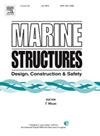几何参数对轴向加载CFDST弦- CFST支撑k节点极限强度的影响
IF 4
2区 工程技术
Q1 ENGINEERING, CIVIL
引用次数: 0
摘要
双皮钢管混凝土(CFDST) k形节点的最大冲剪水平出现在弦撑交点。此时增加外管的截面壁厚会增加断裂的风险,从而危及整个关节。为了消除这一缺点,本研究提出了在内外弦之间以及圆空心截面支撑构件内部实施自固结混凝土(SCC)的替代方法,以提高承载能力并消除主弦塑性。通过室内试验和非线性参数有限元(FE)分析,研究了海上导管架节点构件的几种力学和几何特征的影响,包括核心混凝土抗压强度(fc ')、弦有效长径比(α=2L/D)、支撑与弦直径比(β= D/ D)、弦半径与壁厚比(γ=D/2T)、支撑间隙比(ζ=g/D)、弦与弦角(θ)、和撑弦壁厚比(τ=t/ t)对节点整体延性和强度承载力的影响。结果表明,弦撑角较大的K型节点的延性系数一般较低。此外,当CFDST k -节点构件填充核心混凝土时,在弦撑相交点保持完整的情况下,支撑单元也会发生屈曲。此外,与未填充混凝土的节点相比,混凝土填充节点的峰值荷载几乎是其两倍,初始刚度也更大,这是因为约束混凝土在提高CFDST k型节点的整体承载力方面做出了贡献。本文章由计算机程序翻译,如有差异,请以英文原文为准。
Effect of geometric parameters on ultimate strength of axially-loaded CFDST chord to CFST brace K-joints
The highest punch shear stress levels at concrete-filled double-skin steel tube (CFDST) K-joints form at chord-brace intersecting point. Increasing the section wall thickness of the outer tube at this point enhances the risk of fracture, thus endangers the entire joint. In order to eliminate such shortcoming, the present study proposes an alternative approach of implementing self-consolidating concrete (SCC) in the space between the inner and outer chords, as well as inside the circular hollow section (CHS) brace members, so as to improve load capacity and eliminate main chord plastification. A laboratory experiment followed by a nonlinear parametric finite element (FE) analysis were done to examine the effects of several mechanical and geometric features of an offshore jacket joint members, including core concrete compressive strength (), chord effective length-to-diameter ratio (), brace-to-chord diameter ratio (), chord radius-to-wall thickness ratio (), brace gap ratio (), chord-to-brace angle (), and brace-to-chord wall thickness ratio () on the overall joint ductility and strength capacity. Findings show that K- joints with a higher chord-brace angle demonstrate lower ductility factors in general. Also, buckling occurs at brace elements while the chord-brace intersecting point remains intact when the CFDST K-joint members are filled with core concrete. Furthermore, joints with concrete infill had almost twice as much peak loads and greater initial stiffness compared to those with no infill concrete, because of the contribution of confined concrete in raising the overall capacity of the CFDST K-joint.
求助全文
通过发布文献求助,成功后即可免费获取论文全文。
去求助
来源期刊

Marine Structures
工程技术-工程:海洋
CiteScore
8.70
自引率
7.70%
发文量
157
审稿时长
6.4 months
期刊介绍:
This journal aims to provide a medium for presentation and discussion of the latest developments in research, design, fabrication and in-service experience relating to marine structures, i.e., all structures of steel, concrete, light alloy or composite construction having an interface with the sea, including ships, fixed and mobile offshore platforms, submarine and submersibles, pipelines, subsea systems for shallow and deep ocean operations and coastal structures such as piers.
 求助内容:
求助内容: 应助结果提醒方式:
应助结果提醒方式:


